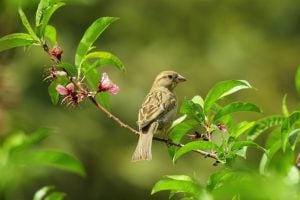Naturescaping: How to Use Native Plants Artfully
Have you ever driven by a home that has clearly embraced native plants with a prairie growing right up to the curb? What was your first thought? As a horticulturist and lover of naturescaping, I am thrilled at the biodiversity and food sources I see. However, as a designer I cringe. My philosophy as a designer is to get as many people as possible planting natives in their yard. In that pursuit I have learned that a major key to that is not freaking out the neighbors. Because of this, I also embrace nativars and a few non-natives especially in your front landscape.
Here are a few suggestions on how to plant natives while also playing nice with the neighbors:
- Take a look around the neighborhood and its plant palette. Does everyone have boxwoods that neatly border their sidewalks or foundations? Consider planting a few (or perhaps our native Inkberry Holly) to anchor your design and give you some evergreen interest come winter. It will give your neighbors something they can recognize and will help to tie your yard into the neighborhood.
- Group and repeat plants in a thoughtful manner that mimics traditional landscaping.
- Embrace nativars. These are cultivars, or selections, of native plants that display various traits such as compact size, longer bloom times, or disease resistance. They tend to be a little better behaved for front yard gardens. Note though, that the further you get from the original native plant, especially with different bloom and foliage colors or bloom forms, the less likely they are to be beneficial to wildlife. And being cultivars, they lack the diversity of the native gene pool. If possible, plant straight native species in backyards where you can get away with a less tidy plant.
- Incorporate elements into the yard that remind people that this is a garden – paths and benches are great focal points and give you an easy way to explore and enjoy your garden.
- Keep bed edges neat and tidy by pruning back plants that wander onto sidewalks. If you do keep lawn, give your bed a clean spade edge and mulch.
- Get involved with programs such as the Audubon Society’s Bring Conservation Home and post their yard sign informing your neighbors of what you are doing.
 Since we’re still in the relatively early days of naturescaping, I feel it’s important that those of us forging the way be good examples. Have a beautiful front landscape that doesn’t intimidate the neighbors and maybe they will ask what you have been up to. Then be the promoter, tell them all about your native plants and everything they are doing for the environment. Maybe they’ll then realize that there’s nothing scary or unkempt inherent with the use of native plants and they’ll be ready to start using them in their own yard.
Since we’re still in the relatively early days of naturescaping, I feel it’s important that those of us forging the way be good examples. Have a beautiful front landscape that doesn’t intimidate the neighbors and maybe they will ask what you have been up to. Then be the promoter, tell them all about your native plants and everything they are doing for the environment. Maybe they’ll then realize that there’s nothing scary or unkempt inherent with the use of native plants and they’ll be ready to start using them in their own yard.
And let your backyard be as wild as you want! It’s your private space, let it be a gorgeous, diverse, oasis for wildlife!
Article written by: Rebecca Eisele, Landscape Designer
Rebecca is our Senior Landscape Designer. She is current acting Vice President of the Landscape Nursery Association of Greater St. Louis and is an inaugural Board Member of the Missouri Green Industry Alliance. Is is also active with Grow Native!, a plant education program of the Missouri Prairie Foundation. Read her last article on planting pollinator host plants here.
